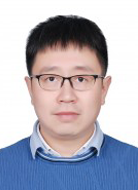
|
|
Prof. Han Huang |
Han Huang is a professor and doctoral supervisor of the School of Software Engineering at South China University of Technology. He holds a PhD in computer science from South China University of Technology. Prof. Huang has been elected for the National Youth Talent Project. He is currently serving as an associate editor of IEEE Transaction on Evolutionary Computation (IF: 16.497) and Complex & Intelligent Systems (IF: 6.700), associate director of the Key Laboratory of Big Data and Intelligent Robots of the Ministry of Education, associate director of Intelligent Simulation Optimization and Scheduling Special Committee, and Director of Teaching Steering Committee for Software Engineering of Undergraduate Colleges and Universities in Guangdong Province. He is also a CCF Distinguished Member and IEEE Senior Member. Prof. Huang has Presided over nearly 20 national and provincial projects including Key Research and Development Program of the Ministry of Science and Technology of China, General Projects funded by National Natural Science Foundation of China, Guangdong Natural Science Funds for Distinguished Young Scholar, etc. He has published more than 60 papers as the first author and corresponding author in IEEE TCYB, IEEE TETC, IEEE TSE, IEEE TEVC, IEEE TIP, IEEE TFS, and Science China, including ESI highly cited papers. He has 36 invention patents granted in China and six invention patents granted in the United States. He won first prize in the Guangdong Scientific and Technological Progress Awards, second prize in the Guangdong Natural Science Awards, Excellent Paper Award of China Simulation Federation, and second prize of Science and Technology Progress of China Society of Image and Graphics. Prof. Huang has been committed to the research on the theories, applications and industrial ecology of intelligent algorithms. He also released five public software systems such as Evolutionary Algorithm Time Complexity Analysis System (www.eatimecomplexity.net), Automatic Generation System of Structural Equation Model (www.autosem.net), and Energy Storage Planning Simulation and Market Development System (http://energystorage.autosem.net). He has completed more than 70 practical application cases of intelligent algorithm technologies.

|
|
Assoc. Prof. Haoji Hu |
Haoji Hu (Member, IEEE) received the PhD degree in audio—visual person identification from the University of Southampton, U.K., in 2007. From 2007 to 2009, he was a postdoctoral researcher in the area of digital watermarking with the Communications and Remote Sensing Laboratory, Universit Catholique de Louvain, Belgium. Since 2009, he has been with the Department of Information Science and Electronic Engineering, Zhejiang University, where he is currently an associate professor. His research interests include image processing, computer vision, and deep learning.

|
|
Assoc. Prof. Boon Giin Lee |
Boon-Giin Lee (Senior Member, IEEE) received the B.I.T. degree in information technology from Multimedia University, Malacca, Malaysia, in 2007, the M.S. degree in electronic engineering from Dongseo University, Busan, South Korea, in 2009, and the Ph.D. degree in electronic engineering from Pukyong National University, Busan, in 2012.,From 2012 to 2013, he was a Researcher with the Ubiquitous Sensor Network Laboratory, Pukyong National University. From 2013 to 2014, he worked as a Software Engineer with Changsung Ace Company Ltd., Seoul, South Korea. From 2014 to 2019, he was employed as an Assistant Professor with the Department of Electronic Engineering, Keimyung University, Daegu, South Korea. Since 2019, he has been an Assistant Professor with the School of Computer Science, University of Nottingham Ningbo China, Ningbo, China, where he became an Associate Professor in 2022. He has published more than 60 papers in journals, conferences, and book chapters. He holds three patents. His research interests include human–computer interaction, intelligent multisensing, and sensor networks.,Dr. Lee was a recipient of the IEEE Sensors Journal Best Paper Award in 2019. He has served as a guest editor for several journals and a reviewer for more than ten journals.
Title: Research on Smart Wearable System in Firefighting
Abstract: This research focus aims to address issues in firefighting and rescue, such as "significant information disparity inside and outside the fire scene, unknown status of firefighters, and difficulty in locating firefighters. Following the "14th Five-Year" National Firefighting Plan and the proposal from the Ministry of Emergency Management on advancing the nationwide construction of smart firefighting, we comprehensively apply emerging technologies like wearable sensors, the Internet of Things, cloud computing, and big data. The goal is to accelerate the development of smart firefighting, promote the deep integration of informatization and firefighting rescue work and achieve the transformation from traditional firefighting to intelligent firefighting, thereby enhancing the safety of rescue personnel.

|
|
Assoc. Prof. Nguyen Quoc Khanh Le |
Le Nguyen Quoc Khanh is an Associate Professor at the Professional Master Program in Artificial Intelligence in Medicine, Taipei Medical University (TMU), Taiwan. In addition, he is also a joint Associate Professor with the International Master/Ph.D. Program in Medicine (IGPM-TMU) and TMU Research Center for Artificial Intelligence in Medicine. He was a Research Fellow at Nanyang Technological University, Singapore. He has been also serving as a Program Committee Member for more than 40 international conferences since 2017 including GIW/ISCB-Asia 2020, IEEE BIBM 2020, ISMCO 2020, IEEE CBMS 2020, IEEE BIBM 2019, InCoB 2019, IEEE CBMS 2019, IEEE BIBE 2019, etc.He is serving as an Editorial Board Member of prestigious SCI journals such as Frontiers in Genetics, PLOS ONE, BMC Bioinformatics, PeerJ, and PeerJ Computer Science. He has been also serving as a Program Committee Member for more than 40 international conferences since 2017 including GIW/ISCB-Asia 2020, IEEE BIBM 2020, ISMCO 2020, IEEE CBMS 2020, IEEE BIBM 2019, InCoB 2019, IEEE CBMS 2019, IEEE BIBE 2019, etc. His research interests focus on applying AI (machine learning, deep learning, and natural language processing) in multidisciplinary studies.

|
|
Assoc. Prof. Xiang Li |
Xiang Li, Associate Professor at School of Mechanical Engineering, Xi'an Jiaotong University, China. My research interests include industrial AI, machine vision, predictive maintenance, intelligent fault diagnosis and prognosis, etc. I am the P. I. of many research and industrial application projects. I have published over 70 research papers on journals of IEEE TNNLS, IEEE TIE, IEEE TII, etc., including 21 ESI highly cited papers, 7 ESI hot papers and 18 ESI research front papers. I'm serving as the Associate Editor for the journal Expert Systems with Applications, etc. My citations on Google Scholar are over 7000 with H-index of 39. I'm honored to be selected as Highly Cited Researcher by Clarivate, and top 2% scientists in career worldwide by Elsevier and Stanford University.
Title: Dynamic vision enabled contactless machine vibration sensing and fault diagnosis

|
|
Prof. Stefano Mariani |
Stefano Mariani received an M.S. degree (cum laude) in civil engineering in 1995, and a Ph.D. degree in structural engineering in 1999; both degrees are from the Polytechnic University of Milan. He is currently a professor of structural mechanics at the Department of Civil and Environmental Engineering of the Polytechnic University of Milan. He was a research scholar at the Danish Technical University in 1997, an adjunct professor at Penn State University in 2007, and a visiting professor at the Polytechnic Institute of New York University in 2009. He is a member of the Editorial Boards of a number of international journals, among which Algorithms, International Journal on Advances in Systems and Measurements, Inventions, Machines, Micro and Nanosystems, Micromachines, and Sensors. He has been a recipient of the Associazione Carlo Maddalena Prize for graduate students (1996), and of the Fondazione Confalonieri Prize for PhD students (2000). His main research interests are: the reliability of MEMS that are subject to shocks and drops; the structural health monitoring of composite structures through MEMS sensors; numerical simulations of ductile fracture in metals and of quasi-brittle fracture in heterogeneous and functionally graded materials; extended finite element methods; the calibration of constitutive models via extended and sigma-point Kalman filters; and multi-scale solution methods for dynamic delamination in layered composites.
Title: Supervised vs unsupervised machine learning strategies to structural health monitoring
Abstract: In recent years, the aging of civil structures and infrastructures in developed countries has provided a perfect playground to develop and assess a number of approaches to structural health monitoring (SHM) driven by artificial intelligence tools. As (big) data can be easily collected by sensors deployed in dense networks, machine and deep learning algorithms can be used to dig into them and select the most appropriate features to classify the current structural state as a normal (defect-free) or a damaged one. In hybrid approaches to the problem, the data collected on the field can be supplemented by additional ones provided by numerical simulations, so that a so-called multi-fidelity framework can be set and exploited. In this presentation, a comparison is provided between supervised and unsupervised approaches to the SHM problem. Strengths and weaknesses of each approach are going to be discussed, with the idea of developing monitoring schemes able to work in real-time. Furthermore, data-driven strategies to optimally deploy the sensors in the network are discussed, to show how attention mechanisms can be leveraged.

|
|
Asso. Prof. Hamed Taherdoost |
Dr. Hamed Taherdoost is an award-winning leader and research and development professional. He is the Founder of Hamta Group | Hamta Business Solution and Associate Professor & Chair of Research and Scholarly Activities Committee at University Canada West. He has over 20 years of experience in both industry and academic sectors. He has organized and chaired numerous workshops, conferences, and conference sessions respectively, and has delivered speeches as chief guest and keynote speaker. Moreover, he is the editorial, reviewer, and advisory board member of some authentic peer-reviewed journals publishing with Taylor & Francis, Springer, Emerald, Elsevier, MDPI, EAI, & IGI Publishing, and Inderscience. His views on science and technology have been published in top-ranked scientific publishers such as Elsevier, Springer, Emerald, IEEE, IGI Global, Inderscience, Taylor and Francis and Dr. Hamed has published over 200 scientific articles in authentic peer-reviewed international journals and conference proceedings ((h-index = 38; i10-index = 80; over 13,000 citations on Google Scholar; over 2.9 million reads and 6,545 citations on ResearchGate; 197,380 downloads on SSRN till December 2023), 30 book chapters as well as 15 books in the field of technology and research methodology. He was ranked as 9th top SSRN Business Authors among world’s most-cited researchers till end of July 2022, awarded the most read contributions from Canada by ResearchGate, July and Octo-ber 2021. His research achievements also include winning several best paper awards, outstanding re-viewer awards and best presentation awards like MLIS 2021 & 2022. He has been listed on the Stan-ford-Elsevier list of World’s top 2% of scientist by August 2021 and 2022. He is a Certified Cyber Se-curity Professional and Certified Graduate Technologist. He is senior member of IEEE, IAEEEE, IASED, IEDRC & HKSRA, Fellow Member of ISAC, WGM of IFIP TC11 - Assurance and Information Security Management, and member of CSIAC, ACT-IAC, and AASHE. Currently, he is involved in several multidisciplinary research projects, including studying innovation in information technology, blockchain and cybersecurity, and technology acceptance.
Title: Integrating Machine Learning into Cybersecurity to Enhance Threat Intelligence
Abstract: Machine learning and threat intelligence combined provide a potent cybersecurity tool. While unstructured data can be analyzed with machine learning, threat intelligence entails gathering and evaluating data to foresee new assaults. Additionally, risk exposure assessment, alert management, raw data analysis, and cyber threat intelligence can all benefit from machine learning. It is imperative that each customer concentrates on the threat landscape that pertains to them, as the majority of the threat landscape is unimportant to most firms. By automatically generating a customized threat profile and making it easier for analysts to enrich that threat profile by providing them with AI-based natural language processing capabilities, the threat environment may be made more personalized. The question of whether open-source intelligence can be successfully incorporated into a practical method that reliably categorizes cyber threat intelligence can also be answered using machine learning. Machine learning and rule-based algorithms are used in the processing pipeline of the threat intelligence machine to convert unstructured data from open, technical sources into organized, useful intelligence. To strengthen cybersecurity, machine learning can also be utilized to visualize trends in CTI data. In summary, this speech discusses how threat intelligence and machine learning together can offer a strong basis for artificial intelligence (AI) solutions that can safeguard companies from online attacks.

|
|
Asst. Prof. Miroslav Vujic |
Miroslav Vujić is an Assistant Professor, Head of Chair of Transport Telematics, and Head of the Intelligent Transport Systems Laboratory at the Faculty of Transport and Traffic Sciences at the University of Zagreb, Croatia. He received a Ph.D. in the Intelligent Transport Systems area with a dissertation Dynamic Priority Systems for Public Transport in Urban Automatic Traffic Control. At the University of Zagreb, Croatia (Faculty of Transport and Traffic Sciences) he teaches courses at undergraduate and graduate levels: Architecture of Intelligent Transport Systems, Basics of Traffic Engineering, Road Telematics, In-Vehicle Telematics. He was the team leader of the H2020 project Twinning Open Data Operational (GA No. 857592) and was a team member of several other EU-funded projects (FP7-317671 Intelligent Cooperative Sensing for Improved Traffic Efficiency – ICSI, FP7 CIVITAS ELAN Mobilising Citizens for Vital Cities - Public Transport Priority and Traveller Information, GA No. 218954), and various other national and regional projects. Area of expertise of asst.prof. Miroslav Vujić is in the field of development and application of Intelligent Transport Systems (ITS) concepts in traffic environments, traffic engineering, and cooperative systems, application and development of dynamic traffic management systems, development of adaptive traffic flow control models, data collection and processing for traffic and transport technology simulations, open data in traffic and transport.
Title: The Development of the Intelligent Cooperative Concept in Urban Traffic System in Croatia
Abstract: As an extension of the intelligent transport system (ITS) concept, the cooperative approach enables communication between the main actors of the traffic system: vehicle, driver, and infrastructure. Present traffic control on signalized intersections in Croatia mostly involves fixed signal timings (based on gathered traffic data such as the number of vehicles, vehicle classification/categories, etc.). With the development of adaptive traffic control, it is possible to adjust the signal timings according to the present traffic situation. In that sense, it is possible to additionally improve traffic control by integrating partial ITS services into a unique cooperative system where traffic data is used jointly to improve the quality of the urban traffic system. Along with the presentation of the concept on a higher level ITS architecture view, one example of the possible implementation of the concept will be presented.
